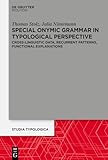Special Onymic Grammar in Typological Perspective : Cross-Linguistic Data, Recurrent Patterns, Functional Explanations / Thomas Stolz, Julia Nintemann.
Material type: TextSeries: Studia Typologica [STTYP] : Beihefte / Supplements STUF - Sprachtypologie und Universalienforschung / Language Typology and Universals ; 34Publisher: Berlin ; Boston : De Gruyter Mouton, [2023]Copyright date: ©2024Description: 1 online resource (XVIII, 258 p.)Content type:
TextSeries: Studia Typologica [STTYP] : Beihefte / Supplements STUF - Sprachtypologie und Universalienforschung / Language Typology and Universals ; 34Publisher: Berlin ; Boston : De Gruyter Mouton, [2023]Copyright date: ©2024Description: 1 online resource (XVIII, 258 p.)Content type: - 9783111331713
- 9783111331973
- 9783111331874
- 415.54
- online - DeGruyter
- Issued also in print.
| Item type | Current library | Call number | URL | Status | Notes | Barcode | |
|---|---|---|---|---|---|---|---|
 eBook
eBook
|
Biblioteca "Angelicum" Pont. Univ. S.Tommaso d'Aquino Nuvola online | online - DeGruyter (Browse shelf(Opens below)) | Online access | Not for loan (Accesso limitato) | Accesso per gli utenti autorizzati / Access for authorized users | (dgr)9783111331874 |
Frontmatter -- Acknowledgements -- Contents -- List of figures -- List of tables -- Abbreviations -- 1 Introduction -- 2 The Grammar of Names vs Special Onymic Grammar -- 3 Empirical bits and pieces -- 4 Leitmotifs of Special Anthroponymic Grammar: Possession -- 5 Recurrent themes of Special Toponymic Grammar: Spatial relations -- 6 Functional-typological evaluation -- 7 Conclusions and outlook -- Primary sources -- References -- Appendix I: List of languages (n = 85) -- Appendix II: Map -- Index of authors -- Index of languages -- Index of subjects
restricted access online access with authorization star
http://purl.org/coar/access_right/c_16ec
For the first time, proper names are made the topic of a cross-linguistic account of morphosyntactic properties which formally distinguish place names, personal names, and common nouns. It is shown that the behaviour of place names and personal names in morphology and syntax frequently disagrees with the rules established for other word classes independent of the language’s genetic affiliation, grammatical structure, and geographic location. Place names and personal names each boast a grammar of their own. They are candidates for the status of a distinct word class. Their special grammar comes frequently to the fore in the domain of spatial and possessive relations. This fact is explained with reference to functional notions.
Issued also in print.
Mode of access: Internet via World Wide Web.
In English.
Description based on online resource; title from PDF title page (publisher's Web site, viewed 25. Jun 2024)


